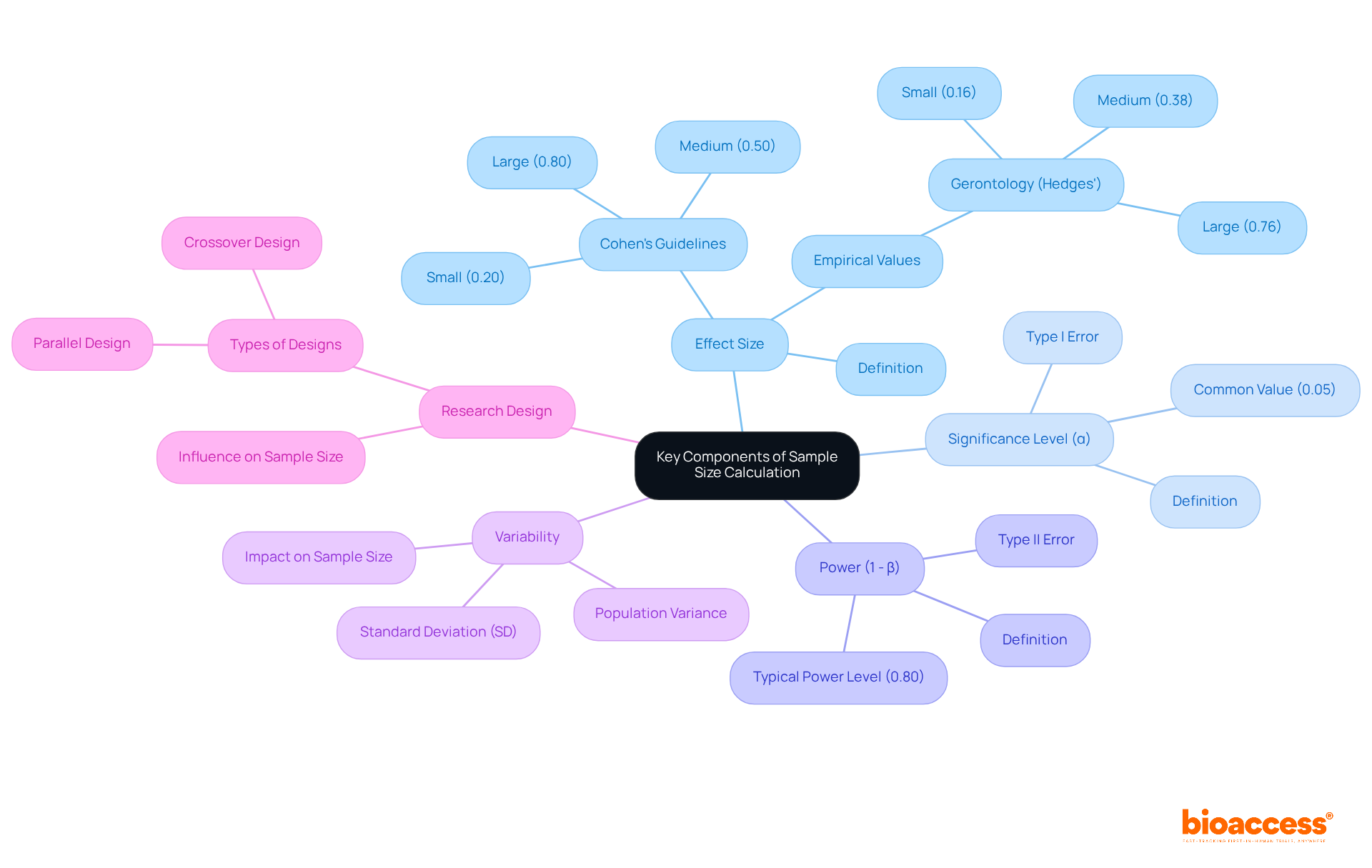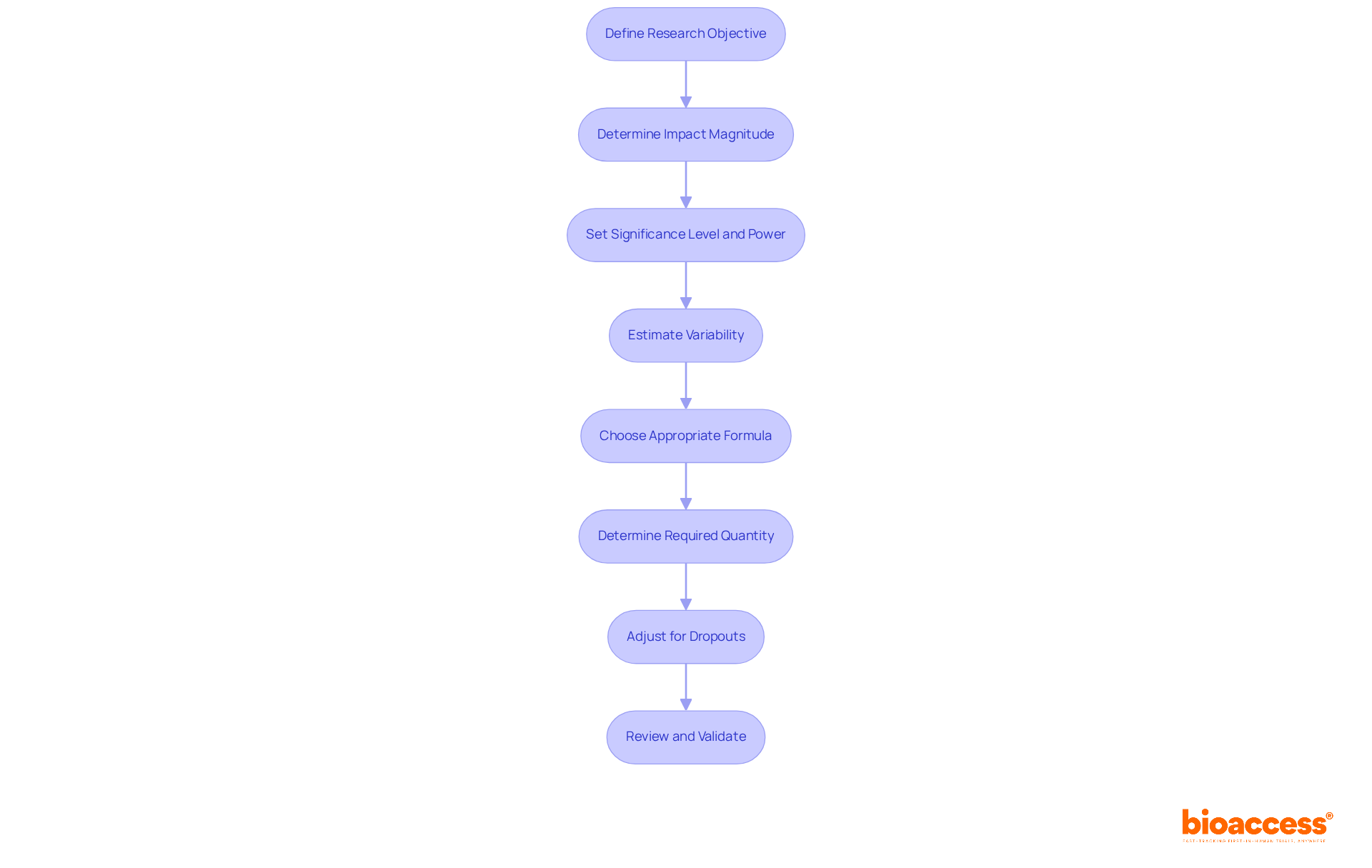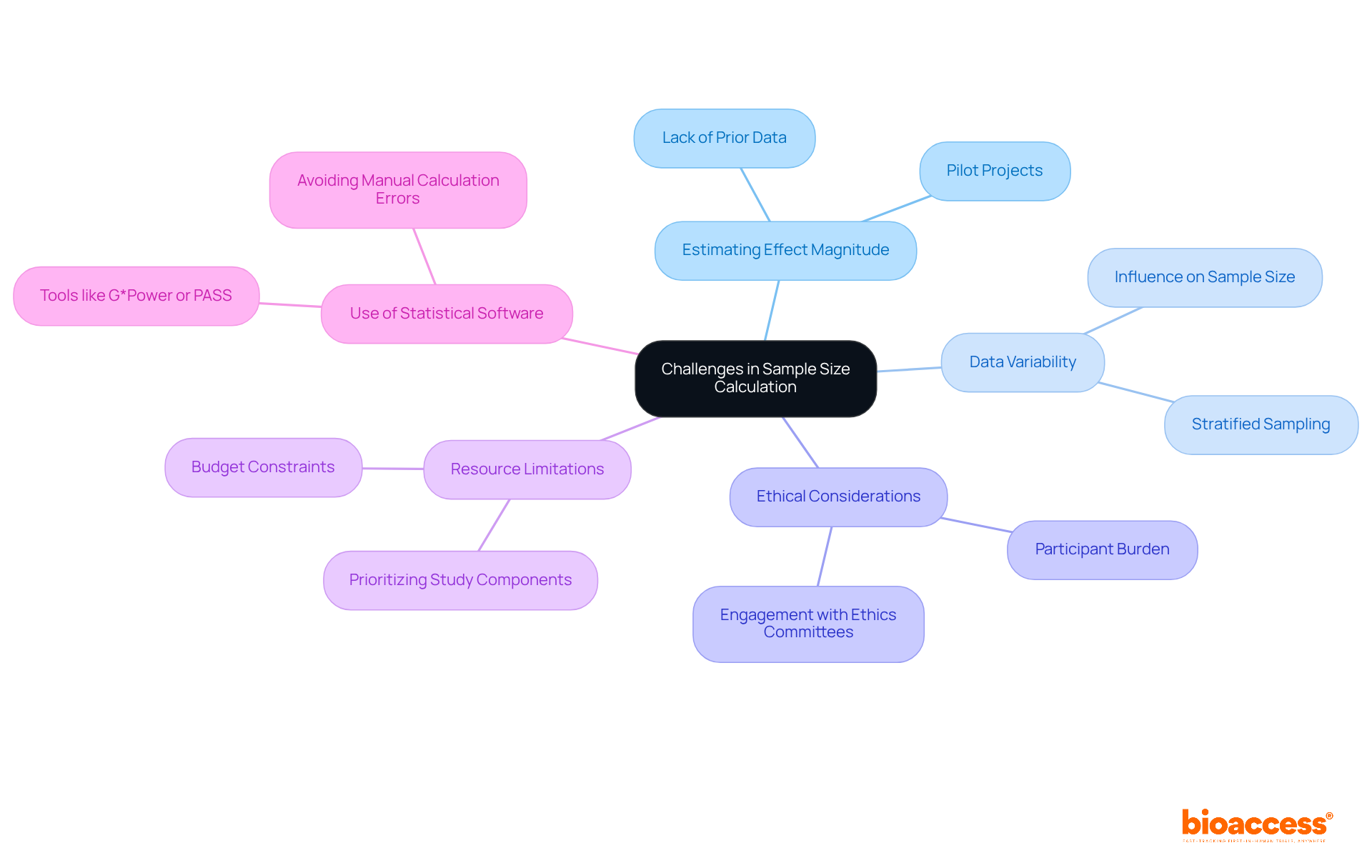


The article emphasizes the critical process of sample size calculation in clinical trials, highlighting its essential role in ensuring reliable results and minimizing errors. It delineates key components such as:
It presents a step-by-step methodology for determining an appropriate sample size. This reinforces the notion that precise calculations are vital for ethical and effective research outcomes. By understanding these components, researchers can enhance the integrity of their studies and contribute to the advancement of clinical research.
In the realm of clinical trials, the significance of sample size calculation is paramount; it serves as the backbone for producing reliable and valid research outcomes. A well-calibrated sample size not only enhances the statistical power of a study but also addresses ethical considerations by preventing unnecessary exposure of participants to potential risks.
Nevertheless, researchers often grapple with the complexities of estimating the appropriate number of participants, which raises questions about the adequacy and accuracy of their studies.
How can researchers navigate these challenges to master the art of sample size calculation and ultimately fortify their clinical research endeavors?
In clinical trial design, sample size calculation is crucial, as it determines the number of participants needed to produce dependable results while minimizing Type I and Type II errors. A carefully determined number of participants increases the research's ability to identify genuine effects, thus strengthening the trustworthiness of the results.
For instance, recent research indicates that the necessary number of participants for pain reduction investigations is 90 per group, resulting in a total of 180 individuals. In contrast, a placebo-controlled trial evaluating Drug A for sepsis requires a total of 292 infants to identify a 16% difference in cure rates with 80% power and 5% significance.
Undervaluing the number of subjects can lead to statistically non-significant outcomes despite clinical importance, while overvaluing can squander resources and expose unnecessary participants to potential dangers. As J. Faber observes, "The sample size calculation for the number of participants directly affects research results," underscoring its essential function.
A well-defined sample size calculation not only optimizes resource allocation—ensuring efficient use of time and funding—but also aligns with ethical standards in research. Lilian Martins Fonseca asserts, "Samples should not be either too large or too small as both have constraints that can undermine the conclusions derived from the research."
Without proper determination, a study risks being underpowered, resulting in inconclusive outcomes, or overpowered, leading to unnecessary expenditure. Therefore, understanding the significance of sample size calculation is a crucial step in performing effective clinical research.

To effectively conduct a sample size calculation clinical trial, several key components must be identified.
Effect Size denotes the expected difference between groups or the extent of the impact anticipated to be observed. In clinical studies, a greater impact magnitude usually permits a reduced number of participants. Proposed values for impact sizes are 0.20 (small), 0.50 (medium), and 0.80 (large), with a median impact size frequently near 0.20 in individual differences research, as indicated in Cohen's guidelines.
Significance Level (α) is the probability of committing a Type I error, commonly set at 0.05. This serves as the threshold for determining statistical significance, meaning that if the p-value is below this level, the null hypothesis can be rejected.
Power (1 - β) indicates the probability of accurately rejecting the null hypothesis or identifying a change when one exists. A typical power level is 0.80, suggesting an 80% likelihood of identifying an outcome. This is the typical power accepted in a sample size calculation clinical trial, indicating a 20% chance of missing a real difference. For instance, to identify a large effect magnitude (Hedges' = 0.76), a participant count of roughly 1,089 is necessary for 80% power.
Variability significantly affects the number of observations; greater variability requires a larger group to attain the same level of accuracy. Population variance, estimated by standard deviation (SD), is essential for determining the number of observations. If the standard deviation is high, more participants will be required to accurately estimate the effect magnitude.
Research Design influences participant number requirements. Various designs, such as parallel or crossover, might necessitate modifications in the calculation of quantities to guarantee sufficient power and validity. In a crossover design, for example, fewer participants may be needed compared to a parallel design due to each participant serving as their own control.
Grasping these elements is essential for the sample size calculation in a clinical trial, as overlooking any of these factors can result in insufficient research or unwarranted resource use.

To accurately calculate sample size for clinical research, follow these essential steps:
Define the Research Objective: Clearly articulate the primary aim of your research, as this will guide your participant number calculations. For instance, if the goal is to assess the effectiveness of a new treatment, specify the expected outcomes.
Determine Impact Magnitude: Utilize data from previous studies or pilot investigations to estimate the anticipated impact magnitude. This is vital, as the typical impact magnitude in clinical trials can greatly affect participant number requirements. For instance, a small magnitude may require a larger sample to identify significant differences. Cohen recommends using small, medium, and large effect sizes instead of specific values to guide this estimation.
Set Significance Level and Power: Establish your significance level (α), typically set at 0.05, and desired power, commonly at 0.80. These parameters help determine the likelihood of correctly rejecting the null hypothesis.
Estimate Variability: If accessible, utilize data from comparable research to estimate the standard deviation. Understanding variability is vital, as it impacts the precision of your estimates.
Choose the Appropriate Formula: Select the correct formula based on your study design. For example, when comparing two means, the formula is:
n = [(Zα/2 + Zβ)² * (σ1² + σ2²)] / (μ1 - μ2)²
Where:
Determine Required Quantity: Insert your values into the formula to compute the necessary amount. For example, if earlier research indicates an average difference of 5 with a standard deviation of 2, utilize these values to determine your group quantity.
Adjust for Dropouts: Anticipate potential dropouts by increasing your group by a certain percentage, typically between 10-20%. This adjustment ensures that your study remains adequately powered despite participant attrition. For instance, a suggested quantity of 245 permits a 20% nonresponse rate.
Review and Validate: Finally, meticulously review your calculations and underlying assumptions to confirm their accuracy. Engaging with a statistician can provide additional insights and validation. The effect magnitude is defined as the minimum impact an intervention must have to be regarded as clinically or practically significant.
By adhering to these steps, researchers can guarantee that their sample size calculation clinical trial is strong, ultimately improving the reliability and validity of their clinical studies. Furthermore, using tools such as the PSS Health application can simplify the calculation process for the number of participants.

In clinical research, sample size calculation for a clinical trial is essential, yet several challenges may arise.
Estimating effect magnitude often poses a significant hurdle for researchers, who may struggle to assess it accurately due to a lack of prior data. Conducting a pilot project can provide a more precise estimate, enhancing the reliability of the study. Additionally, variability in data can lead to larger sample sizes than anticipated. For instance, a case examination on the decline of physical performance with age illustrates how variability can influence performance metrics. To mitigate this issue, consider employing stratified sampling to reduce variability within groups.
Moreover, as research progresses, factors such as effect magnitude or variability may shift. Thus, it is crucial to consistently review participant calculations to ensure they remain relevant. Ethical considerations also play a vital role; balancing the need for an adequate number of participants with ethical concerns regarding participant burden is paramount. Engaging with ethics committees early in the planning process can facilitate this balance.
Resource limitations, such as budget constraints, may restrict the number of specimens available for study. In such scenarios, prioritize the most critical components of your study design to ensure meaningful results. Furthermore, leveraging statistical software for complex calculations is advisable, as manual calculations can introduce errors. Familiarize yourself with tools like G*Power or PASS for precise determination of the required number of subjects.
It is significant to note that world record 100m times have decreased by 6.5% since 1936, underscoring the importance of precise calculations in understanding performance metrics over time. As the originator of the initial graphs mentioned, the argument regarding sample size is a concern that must not be overlooked. Addressing variability in data is crucial, as it can significantly affect the sample size calculation for a clinical trial and the reliability of study outcomes.

Determining the appropriate sample size is a fundamental aspect of clinical trial design, directly influencing the reliability and validity of research outcomes. A well-calculated sample size enhances the likelihood of detecting true effects and ensures ethical considerations are met by preventing unnecessary exposure of participants to risks. Understanding the nuances of sample size calculation significantly impacts the success of clinical research.
Key components—such as effect size, significance level, power, and variability—are critical in establishing a robust sample size. By following a systematic, step-by-step methodology, researchers can accurately assess their needs and make informed decisions about participant numbers. Additionally, recognizing common challenges like estimating effect size and addressing variability enables researchers to navigate the complexities of sample size determination more effectively.
Ultimately, the importance of precise sample size calculation cannot be overstated. It serves as the backbone of credible clinical research, influencing not only the statistical outcomes but also the ethical integrity of studies. Researchers are encouraged to invest time in mastering sample size calculations, utilizing available tools and resources to enhance their studies. By doing so, they contribute to the advancement of medical knowledge and the safety of participants involved in clinical trials.
Why is sample size calculation important in clinical trial design?
Sample size calculation is crucial because it determines the number of participants needed to produce reliable results while minimizing Type I and Type II errors, thus enhancing the ability to identify genuine effects and strengthening the trustworthiness of the results.
How many participants are typically needed for pain reduction investigations?
Recent research indicates that 90 participants per group are necessary for pain reduction investigations, totaling 180 individuals.
What is the required sample size for a placebo-controlled trial evaluating Drug A for sepsis?
A placebo-controlled trial evaluating Drug A for sepsis requires a total of 292 infants to identify a 16% difference in cure rates with 80% power and 5% significance.
What are the consequences of undervaluing or overvaluing the number of subjects in a study?
Undervaluing the number of subjects can lead to statistically non-significant outcomes despite clinical importance, while overvaluing can waste resources and expose unnecessary participants to potential dangers.
How does sample size calculation affect resource allocation in research?
A well-defined sample size calculation optimizes resource allocation, ensuring efficient use of time and funding, and aligns with ethical standards in research.
What are the risks of not properly determining sample size?
Without proper determination, a study risks being underpowered, resulting in inconclusive outcomes, or overpowered, leading to unnecessary expenditure.
What do experts say about the importance of sample size calculation?
Experts emphasize that sample size calculation directly affects research results, highlighting its essential role in conducting effective clinical research.